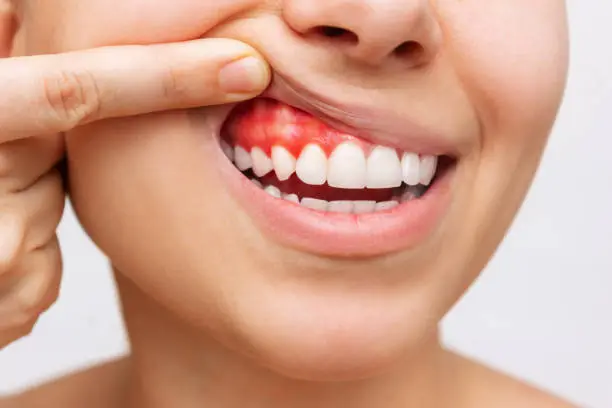A Solo Swelling: Unveiling the Reasons Behind a Swollen Gum Around One Tooth
A throbbing toothache accompanied by a swollen gum – a dental duo that can send shivers down anyone’s spine. But fret not, for this targeted swelling, unlike generalized gum inflammation, often points towards a specific culprit. This comprehensive guide delves into the reasons behind a swollen gum around one tooth, explores potential solutions, and offers valuable tips for a speedy recovery.
The Root of the Problem: Why Does Only One Gum Area Swell?
While various factors can contribute to gum inflammation, a localized swelling around a single tooth signifies a more specific issue at play. Here are the leading suspects:
- Food Impaction: Sometimes, stubborn food particles can get lodged between your teeth or underneath the gum line. This trapped food creates an ideal breeding ground for bacteria, leading to inflammation and swelling in the surrounding gum tissue.
- Gingivitis: This is the early stage of gum disease characterized by inflammation of the gums. While gingivitis typically affects the gums around multiple teeth, it can sometimes manifest as localized swelling around a single tooth, especially if there’s a buildup of plaque (sticky bacterial film) in that specific area.
- Abscess: A dental abscess is a pus-filled pocket that forms due to a bacterial infection. This infection can originate from a deep cavity, a cracked tooth, or even gum disease left untreated. An abscess around the root of a tooth can cause significant swelling and pain in the surrounding gum tissue.
- Pericoronitis: This inflammation occurs when the wisdom teeth (third molars) erupt partially or become impacted (stuck below the gum line). The trapped tissue around the wisdom tooth can become infected, leading to swelling, pain, and redness in the gum flap covering the tooth.
Diagnosis and Treatment: Unveiling the Culprit and Finding Relief
To determine the exact cause of your swollen gum and recommend the appropriate treatment, your dentist will likely conduct a thorough examination. This might involve:
- Visual Inspection: The dentist will examine your mouth to assess the extent of swelling, redness, and any signs of infection.
- X-rays: X-rays can reveal hidden cavities, cracks in the tooth, or any underlying bone involvement related to an abscess.
- Dental Probing: A small, blunt instrument might be used to gently measure the space between the tooth and gum, helping assess gum health and detect potential pockets of infection.
Based on the diagnosis, your dentist might recommend one or more of the following treatments:
- Debridement: For food impaction, your dentist will remove the offending food particle using specialized tools.
- Professional Cleaning: If gingivitis is the culprit, a professional cleaning to remove plaque and tartar buildup is essential.
- Antibiotics: For an abscessed tooth, antibiotics will be prescribed to combat the infection. Depending on the severity, root canal therapy or tooth extraction might be necessary.
- Wisdom Tooth Extraction: If pericoronitis is the cause, removing the impacted wisdom tooth is typically the recommended course of action.
Remember: Early diagnosis and treatment are crucial for a speedy recovery and preventing complications.
Self-Care Strategies: Soothing the Swell While Seeking Help
While waiting for your dental appointment, here are some steps you can take to manage discomfort and promote healing:
- Over-the-Counter Pain Medication: Over-the-counter pain relievers like ibuprofen or acetaminophen can help manage the discomfort associated with the swelling.
- Warm Salt Rinse: Gently rinsing your mouth with warm salt water (dissolve half a teaspoon of table salt in a glass of warm water) several times a day can help reduce inflammation and promote healing.
- Cold Compress: Apply a cold compress to the outside of your cheek near the affected area for short intervals (15-20 minutes at a time) to reduce swelling.
Disclaimer: These are general recommendations. Always follow your dentist’s specific instructions for treatment and recovery.
Frequently Asked Questions (FAQ)
Q: Should I be worried about a swollen gum around one tooth?
A: While a localized gum swelling might not always indicate a serious issue, it’s best to schedule an appointment with your dentist to determine the cause and receive prompt treatment.
Q: Can a swollen gum around one tooth go away on its own?
A: In some cases, like a minor food impaction, the swelling might subside on its own. However, it’s crucial to see a dentist for proper diagnosis and to rule out any underlying issues that require treatment.

